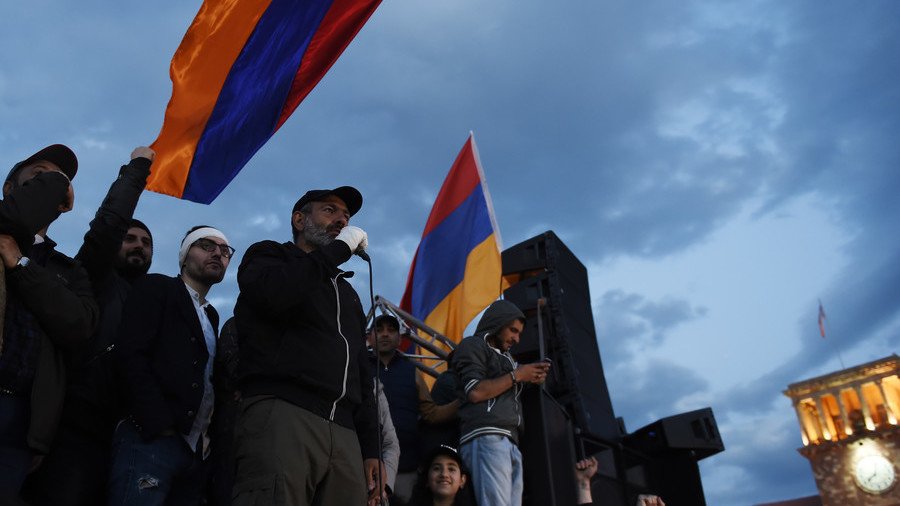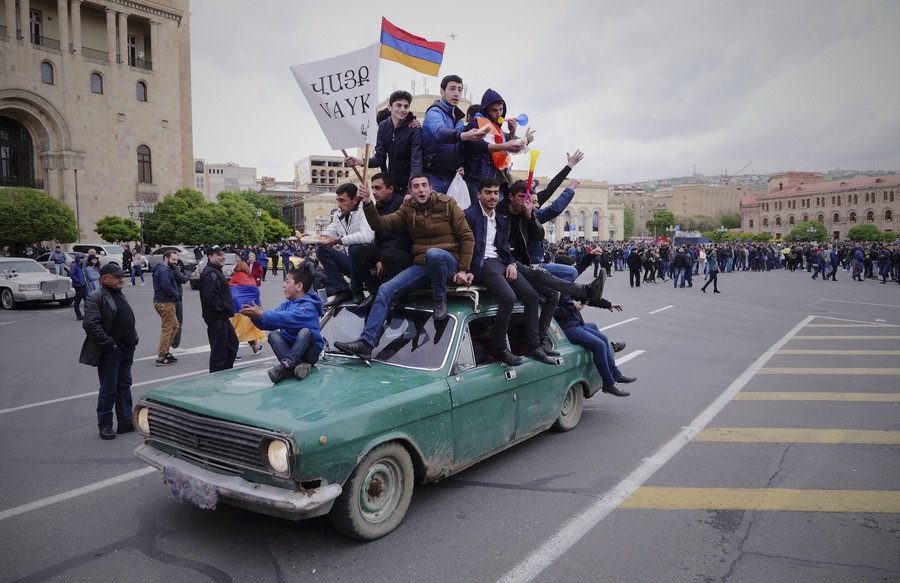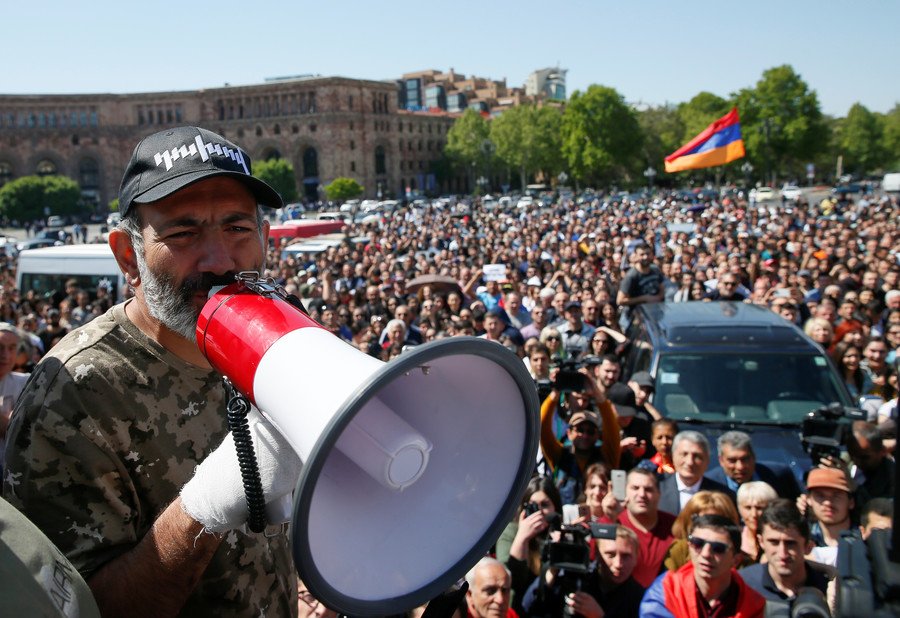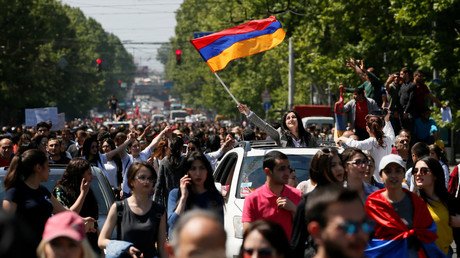Leader’s ambition risks turning street protest victory into mob rule in Armenia – experts

After ousting the PM, an Armenian protest leader attempts to ride the momentum, but risks plunging the inherently vulnerable country into chaos with a damaging power grab, observers tell RT.
Armenia, a small post-Soviet country with a baggage of economic and geopolitical problems, was gripped by a wave of mass protests for almost two weeks. They were triggered by a decision by its long-time President Serzh Sargsyan to break his promise and seek the office of prime minister, which was greatly empowered by a constitutional reform he helped to pass. Charismatic protest leader Nikol Pashinyan rallied the crowds against Sargsyan, disrupting life in capital Yerevan and eventually forcing his opponent to resign on Monday.
Despite this success, Pashinyan continues to call on his supporters to stay in the streets and keep the pressure on the crumbling ruling coalition. He apparently seeks to ride the calming wave of protest until next week, when the country’s parliament is set to hold an emergency session to elect a new prime minister. Pashinyan says he should have the office and promises a profound reform of the political system in Armenia.
It’s the economy, stupid, but also a broken promise
Sargsyan’s blatant violation of the pledge to leave power may have set off the mass protest in Armenia, but the force behind it was accumulated over long years, during which his government failed to steer the country towards economic growth. The problems are partially explained by Armenia’s perilous geographic location, Vladimir Zharkhin, the deputy director of the Institute of the CIS countries, told RT.
Armenia is landlocked by four countries: Georgia in the north, Azerbaijan in the east, Turkey in the west and Iran in the south. Only the latter has fully normal relations with Yerevan, while two of them are quite hostile.
“The country is in a semi-blockade. With Azerbaijan, it has just a ceasefire, so they cannot trade through it with the outer world. They still have no diplomatic relations with Turkey. Georgia’s uneasy relations with Russia result mean that the railroad, which runs from Armenia to Russia through Georgia and Abkhazia, remains closed. So their foreign trade can only go through a small border with Iran,” he said. “This has significant impact on the economic situation in the country.”
Armenia and Azerbaijan are enemies due to a territorial dispute over a predominantly Armenian region called Nagorno-Karabakh, which was part of Azerbaijan during Soviet times and is effectively controlled by Yerevan currently. The two nations regularly clash with each other, with the latest major flare-up happening in April 2016, which resulted in over 100 people killed on both sides. Many powerful Armenian politicians, including Sargsyan, were part of the movement behind the region’s violent secession from Azerbaijan during the collapse of the USSR. The enmity with Turkey has numerous causes, ranging from Ankara’s rejection of responsibility for the mass killings of Armenians by the Ottoman Empire over a hundred years ago to Turkey’s support of Azerbaijan in its conflict with Armenia.

Armenian’s disaffection with their president-turned-premier was further boosted by his role in suppressing mass protest in March 2008, which marred Sargsyan’s first presidential term, said Andrey Areshev, a researcher at the Institute of Eastern Studies in the Russian Academy of Science. Organized by his main rival over alleged violations during the election, they turned violent and left nine people killed and dozens injured.
“It’s no coincidence that the number of people protesting in Yerevan rose dramatically after April 22, when during three-minute negotiations with Pashinyan Sargsyan hinted that the 2008 crackdown may be repeated,” he told RT. “This angered middle-aged and elderly people, who took to the streets and joined the youth there.”
Reinventing the government
Sargsyan decided not to escalate the tension and resigned both as prime minister of Armenia and as the chair of the Republican Party, which, together with the Armenian Revolutionary Federation, formed the current ruling coalition. The parliament is slated to convene for an emergency session on May 1 and is likely to elect a new prime minister, who will serve until a snap parliamentary election can form a new legislature that correctly represents the wishes of Armenians.
There is, however, a dispute over who that temporary leader of Armenia should be, with Pashinyan seeing himself in the office, depicting himself as “a prime minister of the people.” The Republican Party sees his demand, which is backed by street pressure, as unconstitutional.
Pashinyan may have seized a wave of public anger and managed to force Sargsyan to resign, but his ability to capitalize further on that success is doubtful, Konstantin Tasits from the Russian Institute of Strategic Studies told RT.
He pointed out that during the previous parliamentary election the entire opposition bloc Yelk, of which Pashinyan’s Civil Contract party is only a part, managed to score less than eight percent of the vote, winning nine seats in the 105-seat legislature. Karen Karapetyan, who served as the prime minister since 2016, was replaced briefly by Sargsyan last week and is now back in the same chair until a new vote in the parliament, is a strong contender for leadership, Tasits said.
“[Pashinyan] currently symbolizes for some Armenians their wish to change the things. But Karen Karapetyan is quite popular too. His time at the helm was quite positive for the Armenian economy. Last year, it grew by 7.5 percent and the first months of this year have shown growth as well,” he said. “The situation is very fluid and the outcome will depend on which side manages to convince the people of Armenia that they are better suited to lead the country out of the current crisis.”
No Maidan win, hopefully
The current situation may be tempting for Pashinyan to use what remaining emotional strength the wave of protests have and use it to grab power by force. The post-Soviet landscape is full of examples of how street protests can be used to overthrow the government, rather than take power through the ballot box.
“There is some lingering revolutionary euphoria and a wish to push changes through. But it is obvious that allowing crowd whims to replace proper political process is dangerous. It would be better if the situation stayed in the boundaries of the law,” Tasits said.
Armenia’s neighbor Georgia saw one vivid example of a charismatic leader of street protests seizing power in 2003 when Mikheil Saakashvili ousted his former patron Eduard Shevardnadze and became president. His subsequent terms in office were marked by flashy reforms, a bloody crackdown against mass protests in 2007, a disastrous military adventure in 2008, more protests and a gradual descent of Saakashvili into a position of powerlessness.

“In some areas, Pashinyan is being compared to Saakashvili. I wish to think this comparison is not accurate,” Areshev said. But he stressed that the protest in Armenia was motivated mostly by internal factors, not foreign interest, as was with many so-called “colored revolutions.”
The expert warned that Armenia cannot afford a profound political crisis like the one in Ukraine in 2014, during which the Maidan street protest escalated into an armed coup.
“For a country that is de facto at war with Azerbaijan the only good scenario is resolve all differences through peaceful negotiations… and focusing all resources and effort on developing the economy. A political shakeup was inevitable in Armenia, but prolonging this elementary street politics would be highly unadvisable.”
If you like this story, share it with a friend!















